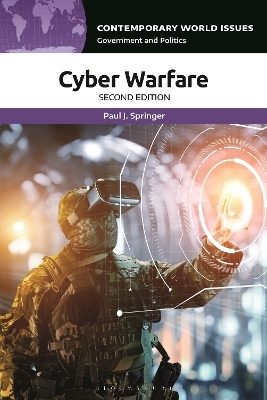
Cyber Warfare
Bloomsbury Academic (Verlag)
978-1-4408-7970-8 (ISBN)
This all-in-one resource explains the world of cyber warfare in authoritative but lay friendly terms. First, it details the historical evolution of cyber warfare and the different forms it can take, from crippling attacks on power grids and communications networks to secret intelligence gathering. From there it moves into a wide-ranging exploration of the main controversies and issues surrounding cyber security and cyber warfare, as well as coverage of major cyber warfare attacks, the organizations responsible, and the steps that the United States and other countries are taking to protect themselves from this constantly evolving threat.
Like all books in the Contemporary World Issues series, this volume features a suite of "Perspectives" in which cyber warfare experts provide insights on various elements of cyber warfare. Other features include informative primary documents, data tables, chronology, and a glossary of terms.
Paul J. Springer is a professor of comparative military studies and chair of the department of research at Air Command and Staff College, USA and a senior fellow of the Foreign Policy Research Institute., USA
Preface
1. Background and History
Information as a Tool of War
The Role of Communications in Modern Warfare
Early Attempts at Encryption
Direct Observation Techniques
The Creation of Cyberspace
The Cyber Attacks Begin
Cyber Enabling in the Nuclear Middle East
Preparation for Infrastructure Cyber Attacks
Russian Hacktivists and National Pride
The Chinese Approach to Irregular Warfare
Non-State Actors and Cyber War
Ukraine and the Digital Conflict
The Current State of Cyber War
References
2. Problems, Controversies, and Solutions
Is a Cyber War Possible?
Cyber as a Military Domain
Cyber Strategy
Instruments of National Power
Cyber Crime, Cyber Espionage, and Cyberterrorism
The Problem of Attribution
The Dangers of Escalation
People and Paranoia
Cyber Ethics
Funding Conflict Through the Cyber Domain
References
3. Perspectives
The DoD Information System Network as a Weapon System Mary E. Braun
The Challenges of Protecting Academia Kurt Peifer
Ransomware and the Private Sector Christopher R. Boom
Waging e-Jihad Heidi Dexter
Cyber Warfare in the Professional Military Education System S. Michael Pavelec
4. Profiles
Alexander, Keith B.
Anonymous
CrowdStrike
Defense Advanced Research Projects Agency
Defense Information Systems Agency (U.S.)
Equation Group
Fancy Bear (Russian Hacking Group)
FireEye, Inc.
Google, Inc.
Government Communications Headquarters (GCHQ, United Kingdom)
Hayden, Michael
Kaspersky, Yevgeniy “Eugene” Valentinovich
Lazarus Group (DPRK Hacking Group)Lehel, Marcel Lazar (“Guccifer”)
Libicki, Martin
Mandiant
McAfee, Inc.
Microsoft Corporation
Mitnick, Kevin
Nakasone, Paul M.
National Security Agency (U.S.)
NATO Cooperative Cyber Defence Centre of Excellence
People’s Liberation Army Unit 61398 (PRC)
Qiao Liang and Wang Xiangsui
RAND Corporation
Rogers, Michael S.
Russian Business Network
Shadow Brokers, The (Hacking Group)
Snowden, Edward
Stuxnet
Symantec Corporation
Syrian Electronic Army
Turing, Alan
U.S. Cyber Command
WikiLeaks
References
5. Documents
Tallinn Manual on the International Law Applicable to Cyber Warfare (2010)
Michael Rogers, “Testimony before the U.S. House Intelligence Committee” (2014)
People’s Republic of China National Cyberspace Security Strategy (2016)
Assessing Russian Activities and Intentions in Recent U.S. Elections (2017)
Military and Security Developments Involving the Democratic People’s Republic of Korea (2017)
Glenn S. Gerstell, “How We Need to Prepare for a Global Cyber Pandemic” (2018)
National Cyber Strategy of the United States (2018)
Executive Order 13800—Strengthening the Cybersecurity of Federal Networks and Critical Infrastructure (2018)
Department of Homeland Security Cybersecurity Strategy (2021)
Cybersecurity & Infrastructure Security Agency, “Russian State-Sponsored and Criminal Cyber Threats to Critical Infrastructure” (2022)
6. Resources
Print Resources
Nonprint Resources
7. Chronology
Glossary
Index
About the Author
| Erscheinungsdatum | 08.08.2024 |
|---|---|
| Reihe/Serie | Contemporary World Issues |
| Verlagsort | London |
| Sprache | englisch |
| Maße | 152 x 229 mm |
| Themenwelt | Literatur ► Biografien / Erfahrungsberichte |
| Natur / Technik ► Fahrzeuge / Flugzeuge / Schiffe ► Militärfahrzeuge / -flugzeuge / -schiffe | |
| Informatik ► Netzwerke ► Sicherheit / Firewall | |
| Sozialwissenschaften ► Politik / Verwaltung | |
| ISBN-10 | 1-4408-7970-2 / 1440879702 |
| ISBN-13 | 978-1-4408-7970-8 / 9781440879708 |
| Zustand | Neuware |
| Haben Sie eine Frage zum Produkt? |
aus dem Bereich


